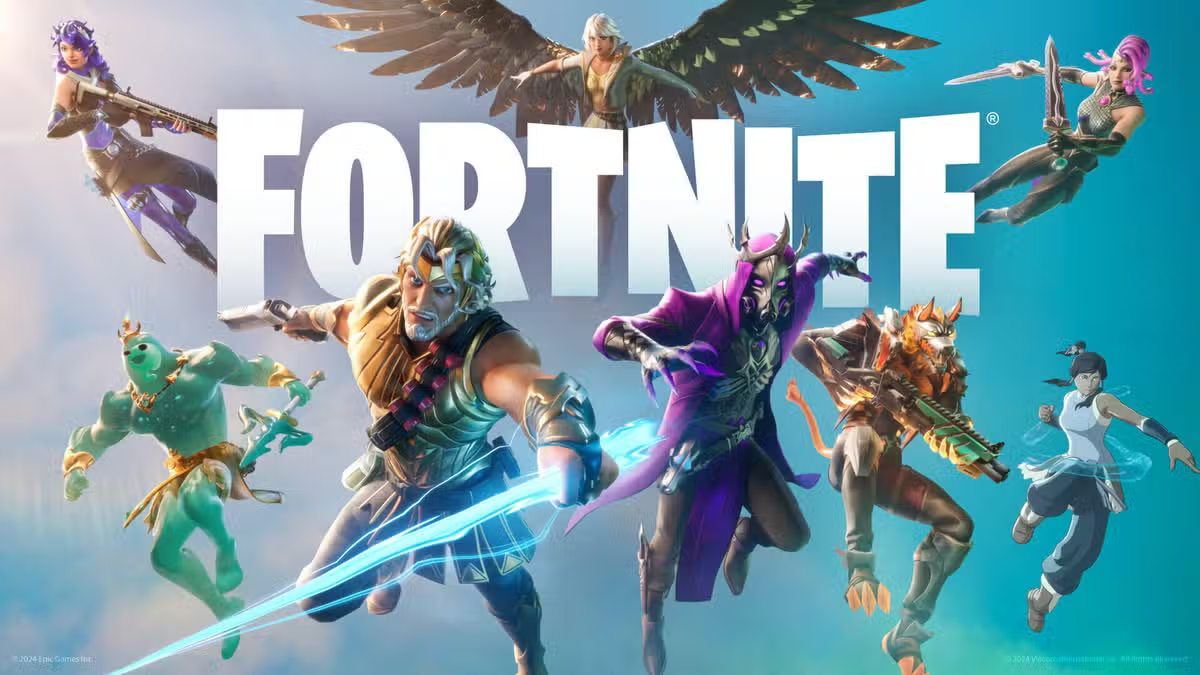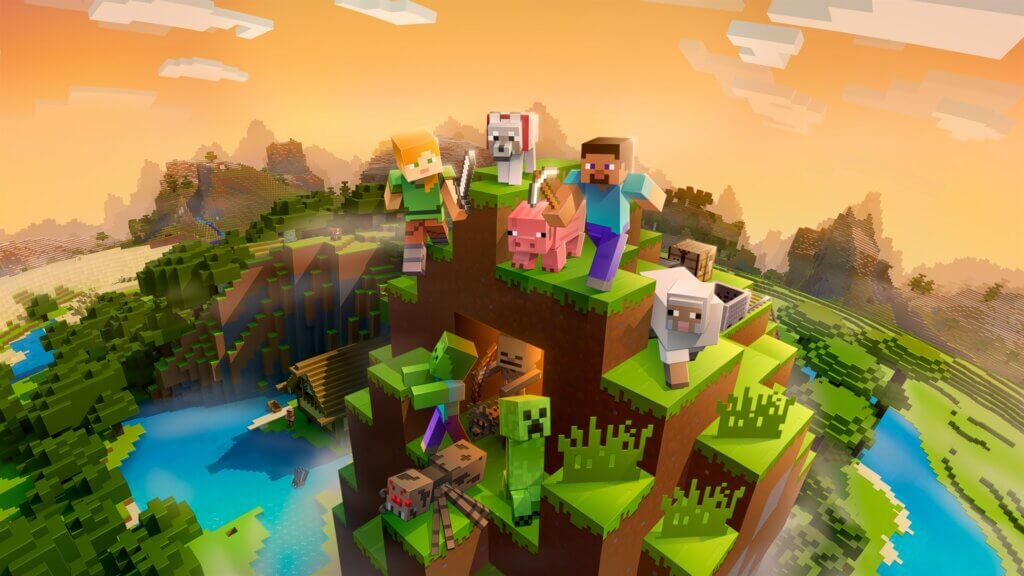
Fortnite is an online multiplayer shooting game, often referred to as a “battle royale” game. In each battle, the aim is to be the last one standing out of 100 players.
As the game progresses, the map that players battle on gets smaller and smaller. Players must collect weapons, build forts and shoot other players to defeat them.
In this blog we will give you all the information you need to understand Fortnite’s gameplay, some of the possible risks that your child may encounter whilst playing it, and how you can support them.
How old should my child be to play Fortnite?
The overall PEGI age rating for Fortnite is 12. However, some of the experiences available in the game have lower age ratings, such as Lego Fortnite (PEGI 7) and Rocket Racing (PEGI 3).
The 12 rating is because of in-game violence and, in the Fortnite Festival experience, bad language and sexual lyrics in the songs a player might hear.
How do you play Fortnite?
Fortnite can be played on a wide variety of consoles, computers and devices, such as PlayStation 4, PlayStation 5, Xbox One, Nintendo Switch, PC, iOS and Android. It also features cross-platform play, which means players can play with each other even if they are playing on different devices.
The main gameplay in Fortnite Battle Royale involves competing in online battles, with the aim of being the last one standing out of 100 players. Players can compete against each other in solo, duo, or up to four player squads.
As time goes on, a storm in the game gradually makes the map smaller, which pushes players closer together. Players use both guns and other weapons to defeat each other. Players also use their time scavenging for more weapons, items, and resources to help them.
Fortnite also includes other game modes and experiences. For example, in ‘Fortnite: Save The World’, players complete specific missions and work their way through a campaign, either solo or as a team, fighting back against the incoming storm. As well as rescuing survivors, players will build defensive structures, fight enemies, and upgrade items and Storm Shields.
Other game experiences include Fortnite Festival (a music and rhythm action game where players can perform songs), Lego Fortnite (a Lego version of Fortnite aimed at younger players), and Rocket Racing (a racing spin-off game).
What terms might my child use when playing Fortnite?
Chapter: regular updates to the game, which usually last a year or two. They give players a new map to play on, as well as other new features.
Season: each chapter is divided into multiple seasons, which last around 90 days each, and come with smaller map changes, new themes and new battle passes.
Skin: an outfit or cosmetic change to the appearance of a player’s character.
Emote: a special animation that your character can perform, such as dances, gestures, and pop culture references.
Experience Points: gained by players by completing specific challenges, through combat, and through building and looting, experience points (or ‘XP’) allow players to advance to the next level.
Battle Pass: an item bundle that players can exchange for experience points they’ve gained each season, from which they will receive rewards.
V-Bucks: Fortnite’s in-game currency used to purchase new ‘skins’ and items. Players use real money to purchase different amounts of V-Bucks.
Loot Llama: a type of item bundle that offers lots of rewards when opened, which can be purchased or earned through gameplay.
What are ‘battle passes’ and why does my child want one?
Each season, Fortnite releases battle passes, which are item bundles that players can exchange for experience points they’ve gained that season, in return receiving rewards.
There are two versions of a battle pass: a paid premium pass, which gives the player over 100 rewards, and a free pass which offers a smaller selection of items.
How do you make a report on Fortnite?
You can report a player in the menu icon. From this menu, click the three lines sometimes called a hamburger menu) and select REPORTING. Choose Report Player, and then select the reason you want to report the other player. Select the name of the player you want to report. You can also choose to block the reported player at this point. Once you have completed all of these steps, click ACCEPT to send the report.
You can also use voice reporting on Fortnite, which allows you to submit audio evidence of your voice chat. When voice reporting is turned on, the last five minutes of chat audio are captured on a rolling basis, and will be attached for moderators to review when a report is made. This last five minutes of recording is saved to securely on your device, not the Epic Games servers and epic will only have access to this recording after you have made the report.
Voice reporting is always turned on for players under 18. As a parent, you can manage your child’s voice chat permissions by logging into the Epic Account Portal and using Epic’s parental controls.
To report a voice chat, open the Sidebar and go to the voice chat tab. If you’re in a match, you will be automatically directed to the voice chat tab. Press the Report Conversation button, then press Submit.
Safety considerations
Inappropriate content
The style of Fortnite is cartoon-like, and there is no visible gore when players attack each other. Damage is represented by numbers and depleting health bars instead of blood. Players disappear in a blue light when they are defeated.
In the Fortnite Festival mode, players may hear bad or sexual language in the lyrics of the songs that they perform to.
Interacting with other players
Fortnite is an online multiplayer game, which means that it is very likely that your child will be playing with others online, including players that they only know online. Players have the option to directly interact and communicate with each other, using either the in-game text chat feature or voice chat.
One risk of being able to play the game with others online is that they may be exposed to offensive language. Players may also say unkind and hurtful things.
Another possible risk is that your child might be interacting with other players who they only know online, and not every player may be who they say they are.
Spending money
Although Fortnite is free to download and play, players are given options to purchase additional extras using the in-game currency, called V-Bucks. Players use real money to purchase V-Bucks.
For example, players can make in-game purchases to buy items, such as new weapons and outfits (‘skins’).
Players can also purchase a season or battle pass to access limited in-game purchases, reward items and other aspects of the game.
Loot Llamas can also be purchased, which offer items when opened. Previously, players were unable to see what would be in the Loot Llamas before they purchased them, but this has been changed so they can see inside them first. If these Llamas are earned through gameplay rather than purchasing, then you cannot see what will be inside beforehand.
Players can also purchase The Fortnite Crew subscription for a monthly fee, which gives the player a Battle Pass for the full season and other additional items and features.
Screen time
When a player’s battle in Fortnite comes to an end, the game does encourage players to start a new battle soon after this, so it can be difficult for players to self-regulate and limit their gameplay and screen time.
It is also important to remember that online multiplayer games like Fortnite cannot be paused in the middle of a battle.
Tips to support your child
Remember that online multiplayer games like Fortnite cannot be paused
Although it is important to set limits and expectations around screen time, young people have told us that asking them to pause or end a game in the middle of a battle can be distressing for them and can cause conflict.
Talk to your child about screen time limits
Have a conversation about how much time you are both comfortable with them playing Fortnite and be consistent with these expectations.
Talk to your child about what to do if they experience abuse from other players
Familiarise yourselves with Fortnite’s block and report functions, and remind them to talk to a trusted adult if another player upsets them. If a report is made about a player but that report isn’t dealt with effectively, you can then report it to Report Harmful Content.
Be open with your child about interacting with players online that they only know in the game
Explain to your child that if they should talk to a trusted adult immediately if an online friend asks them: for too much personal information; pictures or videos of themselves or to go on a livestream for them; to move the conversation to another channel, like Whatsapp; or to meet up in person.
If your child tells you about communication like this, you can report that player in the game and to CEOP (Child Exploitation and Online Protection).
Talk to your child about responsible in-game spending
Discuss any limits and allowances that you are going to set them when it comes to spending real money on Fortnite
Make use of Fortnite’s parental controls
Fortnite’s parental controls allow you to: filter swear words in text chat, disable friend requests and turn off voice or text chat; set a password for making in-game purchases; and turn on Playtime Reporting for the game, which will email you weekly play reports. You can find out more about how to set these parental controls on Internet Matters.
Deciding if Fortnite is right for your child
You can research Fortnite further on The Family Gaming Database and Common Sense Media to see if you think it is suitable for your child to play. If you decide that this game is not suitable for your child, The Family Gaming Database can also suggest more age-appropriate alternatives, such as Super Animal Royale and Crab Champions.
If you have decided that the game is not suitable for your child to play, it’s important to have an open conversation with them about why you have come to this decision. So that your child doesn’t feel like this restriction will be in place forever, it can also be a good idea to explain to them when you would be willing to reassess this.


